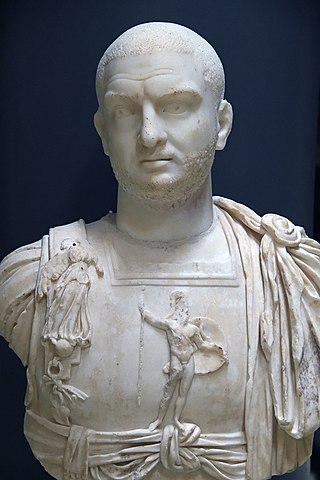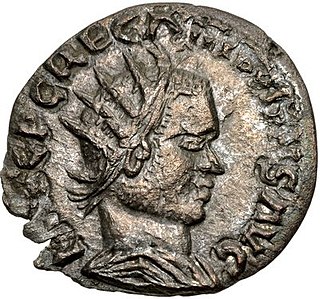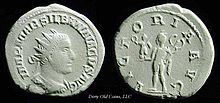
Publius Licinius Egnatius Gallienus was Roman emperor with his father Valerian from 253 to 260 and alone from 260 to 268. He ruled during the Crisis of the Third Century that nearly caused the collapse of the empire. He won numerous military victories against usurpers and Germanic tribes, but was unable to prevent the secession of important provinces. His 15-year reign was the longest in half a century.
The 250s was a decade that ran from January 1, 250, to December 31, 259.

Aurelian was a Roman emperor who reigned from 270 to 275 during the Crisis of the Third Century. As emperor, he won an unprecedented series of military victories which reunited the Roman Empire after it had nearly disintegrated under the pressure of barbarian invasions and internal revolts. Born in modest circumstances, most likely in Moesia Superior, he entered the Roman army in 235 and climbed up the ranks. He went on to lead the cavalry of the emperor Gallienus, until Gallienus' assassination in 268. Following that, Claudius Gothicus became emperor until his own death in 270. Claudius' brother Quintillus then ruled for three months, before Aurelian took the empire for himself.

Valerian was Roman emperor from 253 to spring 260 AD. Valerian is known as the first Roman emperor to have been taken captive in battle, captured by the Persian emperor Shapur I after the Battle of Edessa, causing shock and instability throughout the Roman Empire. The unprecedented event and the unknown fate of the captured emperor generated a variety of different reactions and "new narratives about the Roman Empire in diverse contexts".

Gaius Messius Quintus Trajanus Decius, known as Trajan Decius or simply Decius, was Roman emperor from 249 to 251.

Philip the Arab was Roman emperor from 244 to 249. He was born in Aurantis, Arabia, in a city situated in modern-day Syria. After the death of Gordian III in February 244, Philip, who had been Praetorian prefect, achieved power. He quickly negotiated peace with the Persian Sassanid Empire and returned to Rome to be confirmed by the Senate. During his reign, the city of Rome celebrated its millennium.

The Gallic Empire or the Gallic Roman Empire are names used in modern historiography for a breakaway part of the Roman Empire that functioned de facto as a separate state from 260 to 274. It originated during the Crisis of the Third Century, when a series of Roman military leaders and aristocrats declared themselves emperors and took control of Gaul and adjacent provinces without attempting to conquer Italy or otherwise seize the central Roman administrative apparatus.

Gaius Vibius Trebonianus Gallus was Roman emperor from June 251 to August 253, in a joint rule with his son Volusianus.

Marcus Aemilius Aemilianus, also known as Aemilian, was Roman emperor for three months in 253.

Quintus Herennius Etruscus Messius Decius, known simply as Herennius Etruscus, was briefly Roman emperor in 251, ruling jointly under his father Decius. His father was proclaimed emperor by his troops in September 249 while in Pannonia and Moesia, in opposition to Philip. Decius defeated Philip in battle, and was then proclaimed emperor by the Senate. Etruscus, still a child, was elevated to Caesar (heir) in 250, then further raised to Augustus (emperor) in May 251. When the Goths, under Cniva, invaded the Danubian provinces, he was sent with a vanguard, followed by the main body of Roman troops, led by Decius. They ambushed Cniva at the Battle of Nicopolis ad Istrum in 250, routing him, before being ambushed and routed themselves at the Battle of Beroe. Etruscus was killed in the Battle of Abritus the following year, alongside his father. After the deaths of both emperors, Trebonianus Gallus, who had been governor of Moesia, was elected emperor by the remaining Roman forces.

Hostilian was briefly Roman emperor in 251. Hostilian was born to Decius and Herennia Etruscilla at an unknown date and elevated to caesar in 250 by Decius. After Decius and Herennius Etruscus, Hostilian's brother, were killed at the Battle of Abritus, an ambush by the Goths, Trebonianus Gallus was proclaimed emperor by the legions. Almost immediately, he elevated Hostilian to co-emperor and his own son, Volusianus, to caesar. Hostilian died soon after, either due to plague or being murdered by Trebonianus Gallus.

Marcus Cassianius Latinius Postumus was a Roman commander of Batavian origin, who ruled as emperor of the splinter state of the Roman Empire known to modern historians as the Gallic Empire. The Roman army in Gaul threw off its allegiance to Gallienus around the year 260, and Postumus assumed the title and powers of Emperor in the provinces of Gaul, Germania, Britannia, and Hispania. He ruled for the better part of ten years before he was murdered by his own troops.

Domitian II was a Roman soldier of the mid 3rd century who was acclaimed emperor, probably in northern Gaul in late 270 or early 271, and struck coins to advertise his elevation. It is now generally assumed that this man is to be equated with the Domitianus who is twice mentioned in the literary sources as a significant figure in the politics of the age, but on neither occasion as an outright contender for the Imperial throne.

Gaius Pius Esuvius Tetricus was the emperor of the Gallic Empire from 271 to 274 AD. He was originally the praeses (governor) of Gallia Aquitania and became emperor after the murder of Emperor Victorinus in 271, with the support of Victorinus's mother, Victoria. During his reign, he faced external pressure from Germanic raiders, who pillaged the eastern and northern parts of his empire, and the Roman Empire, from which the Gallic Empire had seceded. He also faced increasing internal pressure, which led him to declare his son, Tetricus II, caesar in 273 and possibly co-emperor in 274, although this is debated. The Roman emperor Aurelian invaded in 273 or 274, leading to the Battle of Châlons, at which Tetricus surrendered. Whether this capitulation was the result of a secret agreement between Tetricus and Aurelian or necessary after his defeat is debated. Aurelian spared Tetricus, and even made him a senator and corrector (governor) of Lucania et Bruttium. Tetricus died of natural causes a few years after 274.

P. C. Regalianus, also known as Regalian, was Roman usurper for a few months in 260 and/or 261, during the Crisis of the Third Century, a period of intense political instability in the Roman Empire. Regalianus was acclaimed emperor by the troops along the Danube river, a region of the empire that frequently experienced barbarian raids, probably in the hope that he might be able to secure the frontier.

Gaius Vibius Volusianus was a Roman emperor from 251 to 253, ruling with his father Trebonianus Gallus.

Jotapian was a usurper in the eastern provinces of the Roman Empire during the reign of Emperor Philip the Arab, around 249. Jotapian is known from his rare coins and from accounts in Aurelius Victor, Zosimus, and Polemius Silvius (Laterculus).
The Geopolitics of the Roman Empire deals with the "inalienable relationship between geography and politics of the Roman Empire". Once the Roman Empire had reached its natural borders, the location of potential threats to the empire and Roman troop locations played a major role in the elevation of Roman Emperors. Access to the troops, their location were crucial to the empire's internal politics, civil wars, and the eventual Fall of the Western Roman Empire.

Coele Syria was a Roman province which Septimius Severus created with Syria Phoenice in 198 by dividing the province of Syria. Its metropolis was Antioch.



















